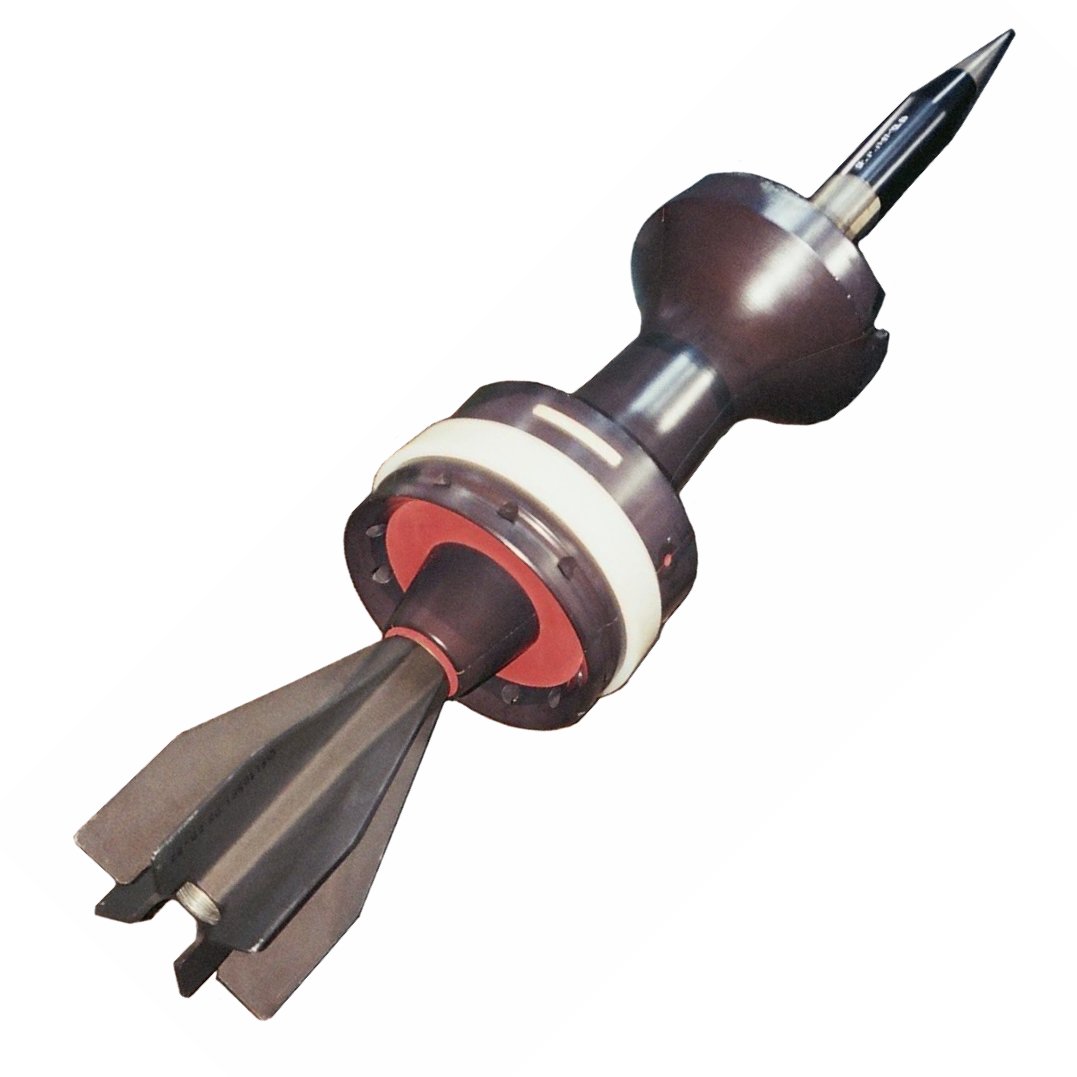|
Compact Kinetic Energy Missile
The Compact Kinetic Energy Missile (CKEM) was a developmental program to produce a hypersonic anti-tank guided missile for the U.S. Army. Lockheed Martin was the primary contractor. The program was the third in a series of projects based on kinetic energy missiles that stretches back to 1981's Vought HVM through the 1990s to 2000s LOSAT and finally to the CKEM. The Army Aviation and Missile Command (AMCOM) developed this program as part of the Army's Future Combat Systems. This missile was primarily an anti-tank weapon, and could be mounted on land vehicles and low-altitude aircraft. The goal of these weapons was to demonstrate a state-of-the-art system for the next generation. The program has since been cancelled. Specifications * Length: * Motor: Solid-fuel rocket * Max range: * Max weight: * Velocity: * Warhead: Kinetic energy penetrator * Penetrator energy: Program status * October 2003 – Lockheed Martin receives $21.3 million contract for CKEM Advanced Technology ... [...More Info...] [...Related Items...] OR: [Wikipedia] [Google] [Baidu] |
Hypersonic
In aerodynamics, a hypersonic speed is one that exceeds 5 times the speed of sound, often stated as starting at speeds of Mach 5 and above. The precise Mach number at which a craft can be said to be flying at hypersonic speed varies, since individual physical changes in the airflow (like molecular dissociation and ionization) occur at different speeds; these effects collectively become important around Mach 5-10. The hypersonic regime can also be alternatively defined as speeds where specific heat capacity changes with the temperature of the flow as kinetic energy of the moving object is converted into heat. Characteristics of flow While the definition of hypersonic flow can be quite vague and is generally debatable (especially due to the absence of discontinuity between supersonic and hypersonic flows), a hypersonic flow may be characterized by certain physical phenomena that can no longer be analytically discounted as in supersonic flow. The peculiarity in hypersonic flow ... [...More Info...] [...Related Items...] OR: [Wikipedia] [Google] [Baidu] |
Anti-tank Guided Missile
An anti-tank guided missile (ATGM), anti-tank missile, anti-tank guided weapon (ATGW) or anti-armor guided weapon is a guided missile primarily designed to hit and destroy heavily armored military vehicles. ATGMs range in size from shoulder-launched weapons, which can be transported by a single soldier, to larger tripod-mounted weapons, which require a squad or team to transport and fire, to vehicle and aircraft mounted missile systems. Earlier man-portable anti-tank weapons like anti-tank rifles and magnetic anti-tank mines, generally had very short range, sometimes on the order of metres or tens of metres. Rocket-propelled high-explosive anti-tank (HEAT) systems appeared in World War II and extended range to the order of hundreds of metres, but accuracy was low and hitting targets at these ranges was largely a matter of luck. It was the combination of rocket propulsion and remote wire guidance that made the ATGM much more effective than these earlier weapons, and gave ... [...More Info...] [...Related Items...] OR: [Wikipedia] [Google] [Baidu] |
Lockheed Martin
The Lockheed Martin Corporation is an American aerospace, arms, defense, information security, and technology corporation with worldwide interests. It was formed by the merger of Lockheed Corporation with Martin Marietta in March 1995. It is headquartered in North Bethesda, Maryland, in the Washington, D.C. area. Lockheed Martin employs approximately 115,000 employees worldwide, including about 60,000 engineers and scientists as of January 2022. Lockheed Martin is one of the largest companies in the aerospace, military support, security, and technologies industry. It is the world's largest defense contractor by revenue for fiscal year 2014.POC Top 20 Defence Contractors of 2014 . Retrieved: July 2015 In 2013, 78% of Lockheed Martin's revenues came from military sales; [...More Info...] [...Related Items...] OR: [Wikipedia] [Google] [Baidu] |
Kinetic Energy Penetrator
A kinetic energy penetrator (KEP), also known as long-rod penetrator (LRP), is a type of ammunition designed to penetrate vehicle armour using a flechette-like, high-sectional density projectile. Like a bullet or kinetic energy weapon, this type of ammunition does not contain explosive payloads and uses purely kinetic energy to penetrate the target. Modern KEP munitions are typically of the armour-piercing fin-stabilized discarding sabot (APFSDS) type. History Early cannons fired kinetic energy ammunition, initially consisting of heavy balls of worked stone and later of dense metals. From the beginning, combining high muzzle energy with projectile weight and hardness have been the foremost factors in the design of such weapons. Similarly, the foremost purpose of such weapons has generally been to defeat protective shells of armored vehicles or other defensive structures, whether it is stone walls, sailship timbers, or modern tank armour. Kinetic energy ammunition, in its ... [...More Info...] [...Related Items...] OR: [Wikipedia] [Google] [Baidu] |
Vought HVM
{{no footnotes, date=November 2015 Vought's HVM, short for Hyper-Velocity Missile, was an anti-tank missile developed during the 1980s. The HVM carried no warhead and killed its targets with kinetic energy alone using a metal rod penetrator. Development as an air-launched weapon for the A-10 Thunderbolt II ended sometime in the late 1980s but continued for helicopter use into the 1990s along with ground-launched (HMMWV) as the larger MGM-166 LOSAT. None of these systems was operationally deployed. The HVM was intended as a fairly inexpensive weapon, compared to the AGM-65 Maverick at least, offering the standoff performance while requiring a minimum of support electronics. The target was acquired using a FLIR system on the launch vehicle, and after launch the missile quickly accelerated to 1500 m/s (5,000 ft/s, 5,400 km/h, Mach 4.3) and into the view of the FLIR, which tracked both the target and missile from that point on. Corrections to the flight path were sent to the missile ... [...More Info...] [...Related Items...] OR: [Wikipedia] [Google] [Baidu] |
LOSAT
The MGM-166 LOSAT (Line-of-Sight Anti-Tank) was a United States anti-tank missile system designed by Lockheed Martin (originally Vought) to defeat tanks and other individual targets. Instead of using a high explosive anti-tank (HEAT) warhead like other anti-tank missiles, LOSAT employed a solid steel kinetic energy penetrator to punch through armor. The LOSAT is fairly light; it was designed to be mounted onto a Humvee light military vehicle while allowing the vehicle to remain air-portable. LOSAT eventually emerged on an extended-length heavy-duty Humvee with a hard-top containing four KEMs used by special operations. Although LOSAT never "officially" entered service, it was used for the smaller Compact Kinetic Energy Missile. History HVM LOSAT developed out of an earlier Vought project, the HVM. HVM was a multi-platform weapon supported by the US Air Force, for the Fairchild Republic A-10 Thunderbolt II, and by the US Army and US Marine Corps, for helicopters and oth ... [...More Info...] [...Related Items...] OR: [Wikipedia] [Google] [Baidu] |
Future Combat Systems
Future Combat Systems (FCS) was the United States Army's principal modernization program from 2003 to early 2009. Formally launched in 2003, FCS was envisioned to create new brigades equipped with new manned and unmanned vehicles linked by an unprecedented fast and flexible battlefield network. The U.S. Army claimed it was their "most ambitious and far-reaching modernization" program since World War II. Between 1995 and 2009, $32 billion was expended on programs such as this, with little to show for it. In April and May 2009, Pentagon and army officials announced that the FCS vehicle-development effort would be canceled. The rest of the FCS effort would be swept into a new, pan-army program called the Army Brigade Combat Team Modernization Program. Development history The early joint DARPA–Army Future Combat Systems program to replace the M1 Abrams main battle tank and Bradley Fighting Vehicles envisioned robotic vehicles weighing under six tons each and controlled remotel ... [...More Info...] [...Related Items...] OR: [Wikipedia] [Google] [Baidu] |
Solid-fuel Rocket
A solid-propellant rocket or solid rocket is a rocket with a rocket engine that uses solid propellants (fuel/ oxidizer). The earliest rockets were solid-fuel rockets powered by gunpowder; they were used in warfare by the Arabs, Chinese, Persians, Mongols, and Indians as early as the 13th century. All rockets used some form of solid or powdered propellant up until the 20th century, when liquid-propellant rockets offered more efficient and controllable alternatives. Solid rockets are still used today in military armaments worldwide, model rockets, solid rocket boosters and on larger applications for their simplicity and reliability. Since solid-fuel rockets can remain in storage for an extended period without much propellant degradation and because they almost always launch reliably, they have been frequently used in military applications such as missiles. The lower performance of solid propellants (as compared to liquids) does not favor their use as primary propulsion in mo ... [...More Info...] [...Related Items...] OR: [Wikipedia] [Google] [Baidu] |
T-72 Tank
The T-72 is a family of Soviet/Russian main battle tanks that entered production in 1969. The T-72 was a development of the T-64, which was troubled by high costs and its reliance on immature developmental technology. About 25,000 T-72 tanks have been built, and refurbishment has enabled many to remain in service for decades. It has been widely exported and has seen service in 40 countries and in numerous conflicts. The T-90 introduced in 1992 is a development of the T-72B; production and development of various modernized T-72 models continues today. Development Development from the T-64 The T-72 was a product of a rivalry between design teams. Morozov KB was led by Alexander Morozov in Kharkiv. Uralvagon KB was led by Leonid Kartsev in Nizhny Tagil. To improve on the T-62, two designs based on the tank were tested in 1964: Nizhny Tagil's Object 167 (T-62B) and Kharkiv's Object 434. Ob. 434 was a technically ambitious prototype. Under the direction of Morozov in Kharkiv, a ... [...More Info...] [...Related Items...] OR: [Wikipedia] [Google] [Baidu] |
Eglin Air Force Base
Eglin Air Force Base is a United States Air Force (USAF) base in the western Florida Panhandle, located about southwest of Valparaiso in Okaloosa County. The host unit at Eglin is the 96th Test Wing (formerly the 96th Air Base Wing). The 96 TW is the test and evaluation center for Air Force air-delivered weapons, navigation and guidance systems, command and control systems, and Air Force Special Operations Command (AFSOC) systems. Eglin AFB was established in 1935 as the Valparaiso Bombing and Gunnery Base. It is named in honor of Lt. Col. Frederick I. Eglin who was killed in a crash of his Northrop A-17 attack aircraft on a flight from Langley to Maxwell Field, Alabama. History Creation and World War II Much of the base was part of a national forest until the outbreak of World War II in Europe when a proving ground for aircraft armament was established at Eglin. The U.S. Forest Service ceded over 340,000 acres of the Choctawhatchee National Forest to the War ... [...More Info...] [...Related Items...] OR: [Wikipedia] [Google] [Baidu] |
_Mach_7_computational_fluid_dynamic_(CFD).jpg)






.jpg)
